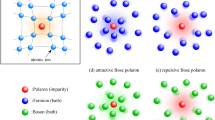Abstract
A brief review of results on initiation of nuclear transformations under conditions of the laser ablation of metals in aqueous media upon exposure to picosecond laser impulses with peak intensity J E ∼ 1010–1013 W/cm2, which is orders of magnitude less than required for the direct initiation of nuclear processes, J E ∼ 1018–1019 W/cm2, is presented. It is shown that the decay rate of radioactive nuclei (using the example of uranium 238) increases significantly (by orders of magnitude), nucleus transmutation processes are initiated (using the example of the transmutation of mercury 196 nuclei into gold 197), and the nuclear fusion of light elements occurs (using the example of tritium nuclei) under such conditions. Concepts regarding the processes of inelastic (with the generation of neutrino-antineutrino pair) interactions between electrons of high (on the chemical scale) energies (∼5–10 eV) and nuclei are developed in order to understand the totality of the current experimental data on the initiation of such processes under conditions of the laser ablation of metals in solutions of ordinary and heavy water. This is reflected in the definition of such processes as nuclear-chemical. It is suggested that the state of nuclear matter in nuclei formed during such interactions is in an unbalanced in-shake-up state, and cannot be pictured in the standard manner, as an ensemble of a certain number of nucleons. Such states are reactive for a wide class of nuclear transformations.
Similar content being viewed by others
References
A. Takahashi, in Condensed Matter Nuclear Science, Proceedings of the 12th International Conference on Cold Fusion, Yokohamacity, Japan, 27 Nov.–2 Dec. 2005 (World Scientific, Singapore, 2005), p. 1.
I. B. Savvatimova and A. B. Karabut, Poverkhnost 1, 63 (1996).
I. B. Savvatimova and D. V. Gavritenkov, in Condensed Matter Nuclear Science, Proceedings of the 12th International Conference on Cold Fusion, Yokohamacity, Japan, 27 Nov.–2 Dec. 2005 (World Scientific, Singapore, 2005), pp. 231–252.
A. B. Karabut, in Condensed Matter Nuclear Science, Proceedings of the 12th International Conference on Cold Fusion, Yokohamacity, Japan, 27 Nov.–2 Dec. 2005 (World Scientific, Singapore, 2005), pp. 214–230.
A. V. Arzhannikov, G. Ya. Kezerashvili, and E. P. Kruglyakov, Phys. Usp. 42, 625 (1999).
M. Fleishmann, S. Pons, and M. Hawkins, J. Electroanal. Chem. 261, 301 (1989).
G. A. Shafeev, F. Bozon-Verduraz, and M. Robert, Phys. Wave Phenom. 15, 131 (2007).
A. V. Simakin and G. A. Shafeev, Appl. Phys. A 101, 199 (2009).
A. V. Simakin and G. A. Shafeev. http://arxiv.org/ftp/arxiv/papers/1001/1001.3574
G. A. Shafeev, in Uranium: Characteristics, Occurrence and Human Exposure, Ed. by A. Ya. Vasiliev and M. Sidorov (Nova Science, 2012), pp. 117–153.
E. V. Barmina, I. A. Sukhov, N. M. Lepekhin, et al., Quantum Electron. 43, 591 (2013).
A. V. Simakin and G. A. Shafeev, Phys. Wave Phenom. 16, 268 (2008).
G. A. Shafeev, A. V. Simakin, F. Bozon-Verduraz, and M. Robert, Appl. Surf. Sci. 254, 1022 (2007).
E. V. Barmina, P. G. Kuzmin, S. F. Timashev, and G. A. Shafeev. http://arxiv.org/abs/1306.0830
N. A. Kirichenko, A. V. Simakin, and G. A. Shafeev, Phys. Wave Phenom. 22 (2014, in press).
L. A. Artsimovich, M. A. Andrianov, E. I. Dobrokhotov, et al., At. Energy 3, 375 (1956).
I. V. Kurchatov, Usp. Fiz. Nauk 59, 603 (1956).
B. A. Trubnikov, Plasma Theory (Energoatomizdat, Moscow, 1996) [in Russian].
V. V. Vikhrev and V. D. Korolev, Plasma Phys. Rep. 33, 356 (2007).
Yu. V. Matveev, Plasma Phys. Rep. 36, 200 (2010).
S. F. Timashev. http://arxiv.org/abs/1107.1799v7
S. Fritzler, Z. Najmudin, V. Malka, et al., Phys. Rev. Lett. 89, 165004 (2002).
C. Labaune, C. Baccou, S. Depierreux, et al., Nature Commun. 4, 2506 (2013), doi:10.1038/ncomms3506, arXiv:1310/2002v1.
K. Hatanaka, T. Miura, and H. Fukumura, Appl. Phys. Lett. 80, 3925 (2002).
M. Stafe, A. Marcu, and N. Puscas, Pulsed Laser Ablation of Solids. Basics, Theory, and Applications (Springer, Berlin, Heidelberg, 2014).
A. A. Serkov, A. A. Akovantseva, E. V. Barmina, et al., Russ. J. Phys. Chem. A 88, 1017 (2014).
A. I. Baz’, V. I. Gol’danskii, and Ya. B. Zel’dovich, Sov. Phys. Usp. 8, 177 (1965).
S. F. Timashev, V. I. Muromtsev, and A. A. Akovantseva, Russ. J. Phys. Chem. A 87, 1063 (2013).
S. B. Borzakov, Ts. Panteleev, A. V. Strelkov, and T. Soldner, The Search for the Dineutron at the High Flux Reactor ILL (Grenoble, France), ISINN-10 (Ob”ed. Inst. Yad. Issled., Dubna, 2003) [in Russian].
K. Seth and B. Parker, Phys. Rev. Lett. 66, 2448 (1991).
B. Pritychenko, arXiv:1004.3280v1.
H.-V. Klapdor-Kleingrothaus and K. Zuber, Particle Astrophysics (Inst. of Physics, Bristol, Philadelphia, 2000).
V. A. Bednyakov, Phys. Part. Nucl. 33, 583 (2002).
Author information
Authors and Affiliations
Corresponding author
Additional information
Original Russian Text © S.F. Timashev, A.V. Simakin, G.A. Shafeev, 2014, published in Zhurnal Fizicheskoi Khimii, 2014, Vol. 88, No. 11, pp. 1805–1815.
Rights and permissions
About this article
Cite this article
Timashev, S.F., Simakin, A.V. & Shafeev, G.A. Nuclear-chemical processes under the conditions of laser ablation of metals in aqueous media (problems of “cold fusion”). Russ. J. Phys. Chem. 88, 1980–1988 (2014). https://doi.org/10.1134/S0036024414110168
Received:
Published:
Issue Date:
DOI: https://doi.org/10.1134/S0036024414110168




